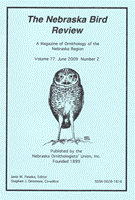Nebraska Ornithologists' Union

Nebraska Bird Review
Date of this Version
12-1986
Document Type
Article
Citation
Stephen M. Kerr, “Avian Cholera in the Panhandle, 1985–1986,” from Nebraska Bird Review (December 1986) 54(4).
Abstract
Between 28 November 1985 and 14 February 1986, over 2,500 waterfowl, 48 Wild Turkeys, and at least one Bald Eagle died due to avian cholera in an area from 5 miles west of Scottsbluff, Nebraska, to 5 miles west of Lingle, Wyoming.
On 28 November a severe snowstorm blanketed the North Platte River valley with 10 inches of snow and wind chills of –20°F. An estimated 50,000 Mallards were concentrated 5 miles west of Scottsbluff, at the headwaters of Spring Creek. The area consists of 2 small dredged channels, 10 feet wide and less than 3 feet deep, and surrounded by 20-feet high willow trees. The spring water flows at 55°F, forming Spring Creek, which is approximately 5 feet wide, 1 foot deep, and flows nearly 3 miles to the North Platte River. Fifteen Mallard carcasses were collected 28 November. Postmortem diagnosis by the National Wildlife Health Center ( NWHC), Madison, Wisconsin, confirmed Pasteurella multicocida (avian cholera) as the cause of death. US Fish and Wildlife Service personnel from Crescent Lake NWR and Nebraska Game and Parks personnel collected carcasses at triweekly intervals over the next 2.5 months. A total of 1,500 waterfowl were incinerated, with over l,200 being Mallards. Other species collected were Pintail, American Wigeon, a Black-billed Magpie, a Common Grackle, a Bald Eagle, domestic fowl, and Wild Turkeys. Total mortalities were estimated at more than 2,500 waterfowl. By 1 December, 60 Mallards had been collected, and the first eagles were seen feeding on carcasses (2 adult Bald Eagles and 2 Golden Eagles). One week later, 4 adult and 5 immature Bald Eagles were observed.


Comments
Copyright 1986 Nebraska Ornithologists’ Union. Used by permission.